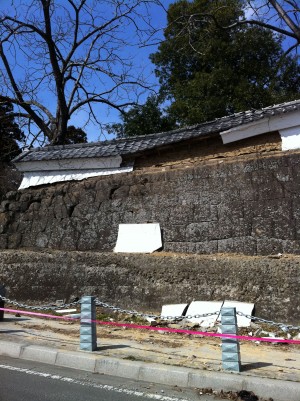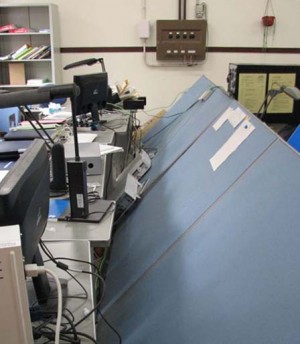On 11 March, the three-day symposium on detector R&D for the International Linear Collider at KEK, Japan, came to a close. It was the final annual meeting of the five-year programme sponsored by Japan Society for the Promotion of Science (JSPS), which had been supporting a large part of Japanese ILC detector activities in recent years. We had submitted a new proposal to JSPS. It had passed document review, and a hearing was scheduled on 30 March.
The symposium ended around noon that day. At around 2:30 pm, I was near the train station of Tsukuba Express on my way back to Sendai. I had not eaten lunch yet, and I was very hungry. I went to a Chinese food shop in a food court, paid for chop suey and pot stickers, and was waiting at a table with a vibrating pager that would alarm me when the food was ready.
Then it looked like my plate was ready, and the pager went off – or so I thought. Actually, the pager was not the only item that was bouncing. Soon it became clear that it was an earthquake. The shake was sharp and rapid, and getting stronger and stronger over tens of seconds. Some people started to run out of the building, but I was still determined to get to the food that I had already paid for. Then the cooks came running out of the shops, and I figured I’d better get out of the building also. When I came out to the street, the quake was still getting stronger, and I had to hold on to a mailbox in order to keep standing. I saw tall buildings swinging like bamboo trees; it seemed they could snap and break down at any moment. It lasted about two minutes. When it subsided, I checked my iPhone and found out that the epicentre was near Sendai – my home town some 400 kilometres away from KEK.
I went to an entrance of a Tsukuba Express station where the train would take me to Tokyo. From there I would take a bullet train to Sendai. There I met two of my students and a few other friends. We then heard an announcement that Tsukuba Express stopped and there was no prospect for restarting. No phone calls to Sendai went through, and the internet connection by cell phone was very slow. Still, the buses were operating more or less as usual – it seems that buses are quite robust against earthquakes. It was quite clear, however, that the bullet train to Sendai would not be operating. So the students and I decided to go back to KEK by bus. There we met several more of my students and friends, and stayed overnight at the dormitory. KEK kindly let us sleep there for free. We gathered together at the lobby of the dormitory and exchanged information. There was neither water nor gas. Electricity was available by an emergency generator, but it could last for only a day or two. Most information was obtained by Internet through cell phones – which railroad sections were still operating and when and where emergency buses run, and, of course, news on the damage. Information about the disaster came out very slowly. It was many hours after the earthquake when we learned that a huge tsunami had hit the coast of Tohoku region. There was no way to get back to Sendai, and the lifeline at KEK was dwindling. So we had to find places to stay for the time being. Luckily all of my students could find relatives and acquaintances to shelter them, and I myself could stay with my brother, who lived not too far from KEK. My brother’s house was in Chiba prefecture, which is next to Ibaraki prefecture where KEK is. Even though many sections of the Japanese railway system in the region were cut off, I was lucky enough to be able to connect the operating sections and emergency buses to get to my brother’s. There, the first task was to help them clean up some mess such as broken glass and pottery. The quake there was not as strong as at KEK, but still it was strong enough to cause many inconveniences. Many of the shelves at supermarkets were empty and it was next to impossible to get gasoline for cars. An important issue was to collect information on members of my group.
With the help of a physicist at KEK who volunteered, we were able to confirm that everybody was fine. Then I called JSPS to ask for a postponement of the hearing. At first, they were adamant that the date could not be changed. With my statement ‘I have to go back to Sendai now to take care of students who lost their places to stay’, they decided to bring it up at the next meeting. Well, my statement was a bit of an exaggeration – only one student had to leave due to damage to her house. Still, many did not have some or all of water, electricity, and gas and they were trying to evacuate from Sendai. A few days later, I got a message on my iPhone that the date had been postponed by three weeks. The hearings of all other proposals had to be delayed also, but this gave us some extra time for preparation.
I returned to Sendai seven days after the earthquake. All major means of transportation to Sendai were still shut down, but I could secure a flight to Yamagata from where it was one-and-a-half hours by bus to Sendai. Fortunately, electricity and water were available at my apartment, and there was no structural damage to the building.
After one day or so of cleaning up, I was able to live there more or less normally. Food was difficult to secure but not impossible, and gasoline in my car happened to be nearly full. Our lab at the university is on the first floor of a three story building buried half underground, and the damage was minimal. There were many tiny cracks on the walls but no structural damage. Electricity was available even though it took about one month for water to come back on. There were three or four people at the lab daily, and we tried to restore the lab so that other group members can come back soon. The computers were up in no time, with a few broken PCs replaced by new ones. Partitions fell down but new legs were purchased and the partitions were propped up securely. This was the end of the fiscal year and we had to close the five-year JSPS program. The ILD workshop at KEK was cancelled and the Japanese Physical Society meeting in Niigata was also cancelled. We had to decide how to deal with the money left unused. I called up our secretary to come help us get though this bureaucratic nightmare. Group members started to come back one by one, and the lab was steadily restoring its normal appearance.
We then had to prepare for the postponed funding review to be held in Tokyo. I moved to Tokyo a few days before the review, and several of us gathered at Tokyo University to prepare for the review. The presentation was 10 minutes long with 15 minutes of questions – this short time would decide on millions of dollars for the next five years. The points to make had to be polished to essences and had to be understood by the reviewers. The strategy was to stress that there was a window of opportunity for the ILC now with LHC’s result coming out for the next few years, that our detector was a revolutionary one with the particle flow algorithms concept, and that the detector technologies developed for the ILC would benefit other fields.
The responses of the reviewers were not particularly encouraging and we were not optimistic. It was more of a surprise, then, that I got a notice of acceptance a few weeks later. The official title of the proposal is ‘grant-in-aid for specially promoted research: a global research and development program of a state-of-the-art detector system for the ILC’. The total amount is seven million dollars over five years, of which 23 percent is indirect cost and one third is for salary to hire six to eight researchers.
There was a report on TV of a baby born in an evacuation camp. My situation is nothing compared to the ordeals experienced by those who were directly hit by Tsunami, but somehow I cannot help thinking of this grant as a precious baby born in the turmoil of the earthquake.




Recent Comments